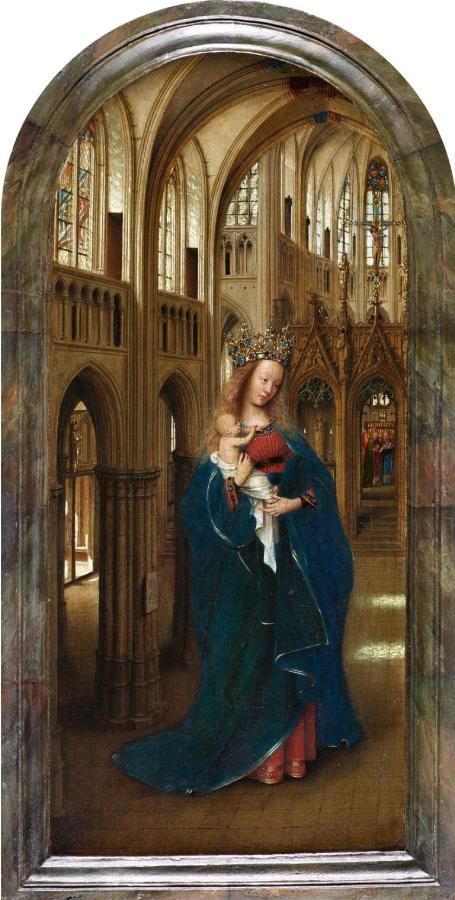Van Eyck, Jan (c.1390-1441)
Madonna in the Church
c.1437–1440
Oil on oak panel, 31.1 x 13.9 cm
Gemäldegalerie, Berlin
The Madonna in the Church is one of the most beautiful and precious works of art created by Jan van Eyck. Copies from the 15th and 16th centuries indicate that the exceptional artistic status of this tiny panel painting was recognised early on. Certainly, the detailed rendering of the architecture and the differentiated gradations of light endow the church interior with an atmosphere of immediacy and
realism. The viewer has the impression of gazing into a timeless world. The light of the bright day which enters through the windows of the clerestory and the side portal, the reflections of sunlight on the shear walls and on the floor of the nave cast a spell, reminding us of the passage of time, which nonetheless seems to stand still here. In this setting, Jan van Eyck has depicted the Virgin and Christ child in monumental dimensions. Mary towers over the vast dimensions of the church architecture, thereby surpassing the limits of human imagination.
Ever since the early Christian era, the Virgin Mary has been referred to as the Temple or House of God, based on the notion that Christ took up residence in her womb as though in a temple. Visible in front of the high altar in the choir of the church are angels, who sing from an antiphonary. They allude to the close relationship between sacrament and redemption, as well as the everlasting mass of the End Time.
In medieval theology, sunlight which penetrates the window without breaking it, becomes a metaphor for Mary, who became a mother while nonetheless remaining intact. This explains why Jan van Eyck took so much care in rendering the sunlight, which must be understood as a symbol of God and an emblem of the Virgin Mary.
When we recall that the choir faces towards the east in Gothic churches, we realise that in the present picture, the sunlight enters the church interior not from the south, but instead – and contrary to reality – from the north. It is a question then not of natural but instead of eternal light, which follows neither the movement of the sun nor of the stars. This symbolism of light experiences a complex extension in the candles that burn in the niche of the rood screen alongside a sculpture of the Virgin. It is apparent that the statue corresponds closely to the lifelike Madonna which confronts us. It almost seems as though, in some miraculous way, this lifeless effigy has been awakened to life. Reality and vision are one. One has the impression of gazing into a distant world, one that seems strikingly real, and is nonetheless remote from reality. (Gemäldegalerie)
